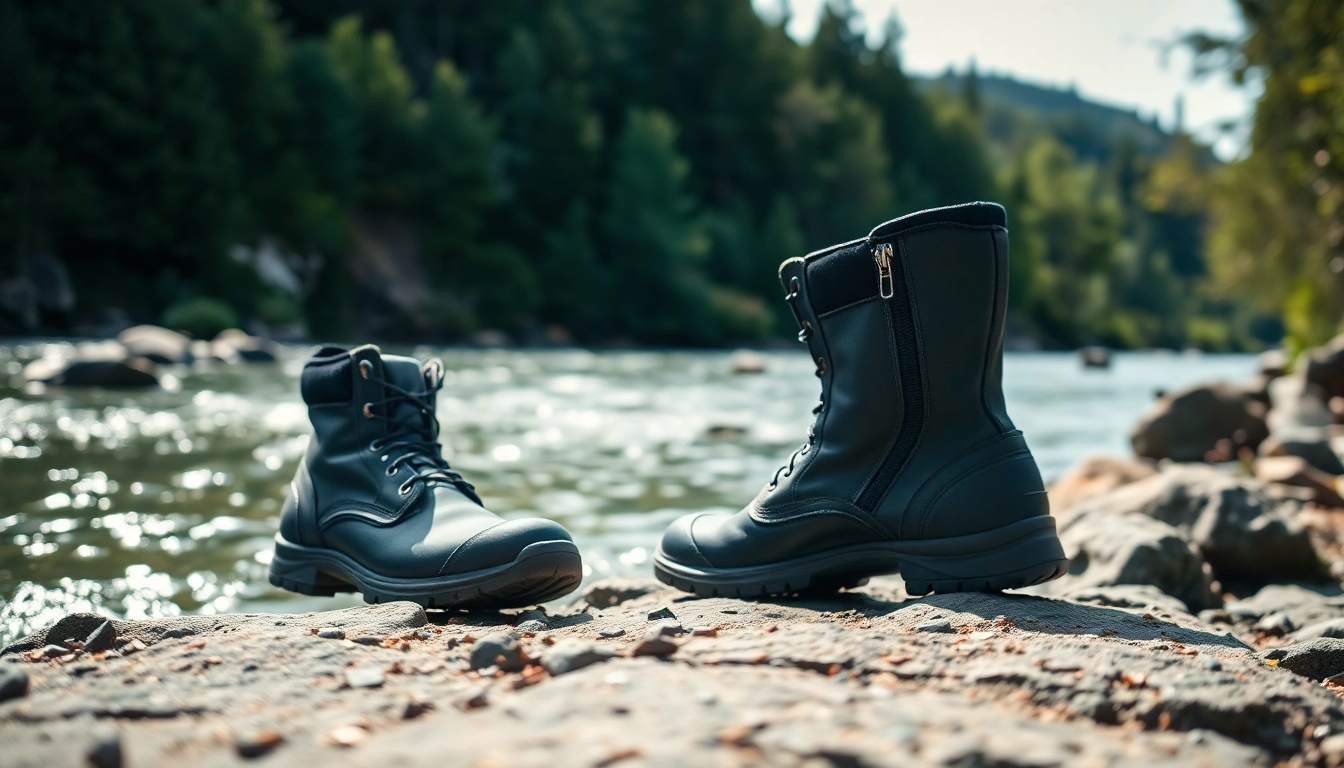Understanding Fly Fishing Boots
What Are Fly Fishing Boots?
Fly fishing boots are specialized footwear designed to enhance the fishing experience, providing traction, protection, and comfort while navigating various aquatic environments. These boots are a vital piece of gear, especially for anglers who need to wade into streams, rivers, or lakes where conditions can be slippery or uneven. Crafted using durable, water-resistant, or waterproof materials, fly fishing boots help keep your feet dry while also offering stability on slippery surfaces.
Key Features of Fly Fishing Boots
When exploring Fly fishing boots, several key features stand out. Understanding these features is crucial when selecting the right pair:
- Waterproofing: Many fly fishing boots are designed to be waterproof to keep feet dry when wading in water.
- Traction: Outsoles often feature specialized rubber with lug patterns designed for superior grip on slippery rocks and wet surfaces.
- Comfort: Good padding, ankle support, and breathable materials provide comfort during extended periods of wear.
- Durability: Heavy-duty materials resist wear and tear, essential for rugged aquatic environments.
- Interchangeable soles: Some models allow users to swap soles to suit changing conditions.
Benefits of Specialty Fly Fishing Boots
Investing in quality fly fishing boots provides numerous benefits:
- Improved Safety: Specialized outsoles enhance stability and reduce the risk of slips or falls in challenging terrains.
- Increased Comfort: The right fit and supportive design lead to less fatigue, allowing for longer fishing sessions.
- Protection: These boots shield feet from sharp rocks, chilly water, and other hazards usually found in aquatic settings.
- Versatility: Many fly fishing boots can perform well in various conditions, accommodating both freshwater and saltwater fishing.
Choosing the Right Fly Fishing Boots
Factors to Consider When Selecting Fly Fishing Boots
Choosing the right fly fishing boots involves evaluating multiple factors to ensure maximum performance and comfort:
- Fit: Ensure the boots fit snugly without being too tight. This helps prevent blisters and discomfort.
- Sole Type: Determine whether you need felt or rubber soles. Felt provides excellent traction in rocky streams, while rubber is suitable for slippery surfaces.
- Weight: Consider lightweight options if you prioritize speed and maneuverability, whereas heavier boots may provide greater protection.
- Waterproofing: Evaluate the level of waterproofing required based on your fishing conditions.
- Height: Choose between ankle-height boots for mobility or higher boots for extra protection from water.
Common Mistakes to Avoid with Fly Fishing Boots
When selecting fly fishing boots, avoiding common mistakes is critical:
- Choosing the Wrong Size: Trying boots on with only thin socks can lead to incorrect sizing. Always try them with your typical fishing socks.
- Ignoring Boot Care: Regular maintenance can significantly extend the life of your boots. Neglecting care may lead to wear and performance issues.
- Overlooking Seasonal Factors: Conditions can vary greatly between seasons; boots that work well in summer may not be practical in winter.
- Forgetting About Breathability: Selecting boots without proper ventilation may result in discomfort during warmer months.
How to Measure for the Perfect Fit in Fly Fishing Boots
Getting the perfect fit for fly fishing boots involves a straightforward measuring process:
- Measure both feet while standing, as the foot can expand slightly.
- Use a soft measuring tape to measure the length from the heel to the longest toe.
- Measure around the widest part of the foot for girth.
- Consult manufacturer sizing charts as different brands may have slight differences in sizing.
Remember to try the boots on with the fishing socks you intend to wear to ensure the best fit.
Types of Fly Fishing Boots Available
Waterproof vs. Water-Resistant Fly Fishing Boots
Understanding the difference between waterproof and water-resistant boots is essential:
Waterproof boots are designed to keep your feet completely dry, often using advanced bonding techniques and waterproof liners. They are best suited for conditions where submersion is likely.
Water-resistant boots provide some level of protection against the elements but aren’t completely waterproof. They may be suitable for light splashes and moisture but may not withstand prolonged exposure.
Studded vs. Non-Studded Fly Fishing Boots
Choosing between studded and non-studded boots largely depends on your fishing environment:
Studded boots contain small metal or carbide spikes that enhance grip on slippery surfaces, making them ideal for rocky rivers or streams.
Non-studded boots offer solid traction without added spikes, making them versatile for different fishing conditions, including trails and slightly slippery terrains.
Lightweight vs. Insulated Fly Fishing Boots
Understanding the distinction between these types is crucial for choosing the appropriate footwear:
Lightweight boots are ideal for warmer climates and extensive hiking as they facilitate ease of movement and reduce fatigue.
Insulated boots are designed for colder conditions, using materials that retain heat. They can help maintain warmth during cold water fishing, ensuring comfort.
Maintaining Your Fly Fishing Boots
Cleaning and Caring for Fly Fishing Boots
Proper care for your fly fishing boots can significantly extend their lifespan. Here’s a comprehensive cleaning routine:
- Remove excess dirt or mud with a soft brush or cloth after each use.
- Use a gentle soap solution and a sponge to clean the boots thoroughly.
- Rinse with clean, cool water to eliminate soap residue.
- Allow the boots to dry naturally in a well-ventilated area away from direct heat sources to prevent material damage.
Repairing Common Issues with Fly Fishing Boots
Common issues may arise, but many are easily repairable:
- Minor Leaks: Use waterproofing sealant on small punctures or leaks to keep them functioning properly.
- Loose Soles: If the soles start to peel, strong adhesive can be used to reattach them securely.
- Worn Liners: If the waterproof liner fails, a proper reconditioning kit can help restore waterproof capabilities.
How to Store Fly Fishing Boots Properly
Storing your fly fishing boots correctly ensures they remain in good condition:
- Ensure they are completely dry before storage.
- Use boot trees or stuff them with newspaper to maintain shape and prevent creases.
- Store in a cool, dry place to avoid mold and deterioration.
- Avoid stacking heavy objects on top to prevent deformation.
Enhancing Your Fly Fishing Experience
Selecting the Right Accessories to Pair with Fly Fishing Boots
Pairing your fly fishing boots with the right accessories enhances your overall experience:
- Waders: When used together, breathable waders provide added protection from cold water.
- Socks: High-quality, moisture-wicking socks prevent blisters and enhance comfort during long fishing trips.
- Belts: A good belt can help secure waders, preventing water from entering.
- Felt or Rubber Sole Options: If your boots allow for sole change, it helps to have both options depending on the fishing conditions.
Local Tips for Fly Fishing Locations and Conditions
Becoming familiar with local fishing spots is essential to enhance your fly fishing experience:
Research popular fishing locations and join local fishing groups to gain insights into seasonal fish patterns, conditions, and appropriate gear. Understanding the ecosystem can help you choose the best time and techniques for fishing.
Connecting with the Fly Fishing Community
Engaging with the fly fishing community offers numerous benefits:
- Participate in local casting clinics to improve your skills.
- Join online forums to exchange experiences and tips with fellow anglers.
- Attend community fishing events or tournaments to network and learn from seasoned anglers.
Building connections within the community can enhance your knowledge, expand your fishing network, and improve your overall experience.





Leave a Reply